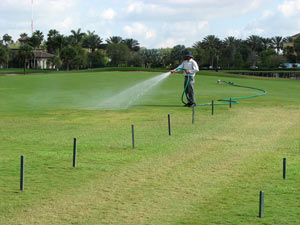Improve Irrigation Systems to Decrease the Impacts of Restrictions
Increased rainfall over the past few weeks has improved golf course quality on recent visits in Southwest Florida. Also, slightly higher irrigation allocations were allowed in March as compared to significantly less amounts in January and February, and this has been a reprieve for some golf courses. Still, many courses were running their staff overtime with hand-watering dry spots to improve fairway turf quality.
 |
|
I recently met Dr. Michael Dukes, University of Florida Associate Professor and Irrigation Specialist, at a recent Florida Turfgrass Association meeting. Dr. Dukes gave a presentation Improving Golf Course Irrigation Scheduling and Efficiencies and I asked his thoughts on the recent irrigation restrictions. Below are some of the highlights of that discussion:
Q: I've heard it said recently that you are working with the water management districts to improve irrigation restriction models. Can you tell us a little about the current situation and how it might improve in the future?
A: Currently irrigation requires permits for users such as golf courses and agriculture. Generally, the permits allow irrigation quantities based on historical weather demands (evapotranspiration, or ET) and historical rainfall. The difference between these two quantities is the required net irrigation amount. Consumptive use permits typically allocate water based on optimum plant growth and a drought probability such as the 2 in 10 year or 1 in 10 year drought, which means that in any given year we have a 20% or 10% chance, respectively, of getting this level of drought. Thus, the allocations are not meant to be adequate for optimum plant growth during all drought scenarios. We are currently in the second year of a significant drought. It is possible that this drought has exceeded the permitted limits; however, we will eventually come out of the drought. Note that the various water management districts use different approaches to permitting. Thus, they may each allocate different amounts for the same given scenario.
Q: Some courses report having less than 30% of their normal allotted water as in previous years, and not the 60% that the South Florida Water Management District is reporting. Should newer restriction models improve water allotments and make restrictions more realistic?
A: At this time period, when water restrictions are extremely tight, we are finding out what levels of water work under given scenarios. In other words, if irrigation uniformity is poor, but rainfall is abundant, then the permitted irrigation limits are never tested in terms of maintaining quality. Now they are being tested. Keep in mind that permitted amounts are not meant to be adequate for all drought scenarios as I described above, and water shortage rules can cut those levels even further to prioritize public health and welfare.
Q: What are economical techniques that golf course superintendents can use to improve their irrigation systems?
A: Perform an irrigation audit. This can be done in-house, or consultants or irrigation contractors can be hired. Fix any obvious issues such as malfunctioning heads, overspray, etc. Once the existing systems are operating as well as practically possible, consider upgrades that may increase efficiency such as re-nozzling. More expensive upgrades include installation of additional heads to increase irrigation uniformity and ultimately efficiency. Maybe least expensive is to fine-tune the operating schedule so that the correct amount is being applied when needed, although restrictions may hamper this approach. We have shown that soil moisture based irrigation control can cut irrigation and achieve good turf quality on landscapes and have a preliminary study that indicates similar trends for golf fairways. In addition, courses should consider using the Florida Automated Weather Network ( http://fawn.ifas.ufl.edu ) to aid in irrigation scheduling. Reduced irrigation of non-critical areas should be considered.
Q: Do you foresee irrigation restrictions as being a normal way of running business for Florida golf courses in the future? If so, what percentage do you feel golf courses will be restricted from now on?
A: As population pressures increase, yes, restrictions are part of the future. It is unknown how many courses will be restricted in the future. This current situation is showing how well the allocated amounts are meeting needs and also forcing courses to become more efficient.
Q: New irrigation systems and improved landscape designs with native plants to reduce irrigated turf acreage can cost millions of dollars for courses. Do you feel that such measures are necessary at this time?
A: As you point out, there are certainly expensive and time consuming strategies to reduce irrigation consumption. However, I am not convinced that we have picked all the "low hanging fruit" with regard to irrigation efficiency. Have courses all performed irrigation audits? Have the systems been tuned up for maximum efficiency, barring major irrigation system replacement? Are all the courses using scheduling techniques and technologies such as real-time ET estimation? I encourage courses to consider these potential solutions as we move forward so that they can be ready for restrictions in the future.
There is no doubt that irrigation will remain an important issue for Florida golf courses in the future, especially during times of drought. Experts like Dr. Dukes are necessary for helping us find common solutions and agreement for both golf courses and regulators.
Source: Todd Lowe, tlowe@usga.org or 941-828-2625
